Scotland and England, Year 2000
August 18 and 19
We started this trip on United Airlines Flight 924, Boeing 777, from Washington Dulles to London Heathrow--transfer to another flight to Edinburgh. There were twelve in our group, but we split it up so six took one flight and six took another flight. When our group got to The Balmoral, David and Virginia Russell were already there--having tea in the Palm Court. We had an easy afternoon--Ed reconnoitered the area while Pam took a nap.
The Edinburgh Festival is held for about three weeks every August. One of the primary purposes of this trip was to take all of David Russell's family (and significant others) to see the Military Tattoo at Edinburgh Castle. During the festival Edinburgh is filled with people and all kinds of entertainment (Fringe events). It is a very lively place.
August 20, Sunday
Family breakfast in the hotel. Ed, Pam, Virginia and Wade went to the St Giles Cathedral for the 11:00am service. The sermon was delivered by Gilleasbuig Macmillan, Minister of St Giles, Dean of the Thistle, Chaplain in Ordinary to Her Majesty the Queen. He gave a wonderful sermon based on Philippians 4:1-13: Verse 8 "Finally, brothers, whatever is true, whatever is noble, whatever is right, whatever is pure, whatever is lovely, whatever is admirable--if anything is excellent or praiseworthy--think about such things." The choir wore robes that looked like monks' robes--white and brown. They have a new organ and the choir is magnificant.
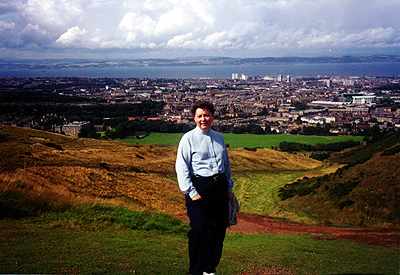 After the service we went to the book fair in Charlotte Square. The children's tent was wonderful but we finally got to the adult tent. We bought two books: one on the Boothe's who founded the Salvation Army. Rev. Macmillan referred to it in his sermon. The other was a book on the Rosslyn Chapel which we planned to visit. We then walked down Rose street looking for a place to eat. Since this was about 3:00pm, most of the pubs had stopped serving food, or had run out. We ended up in the Kennilworth where we had some wonderful lamb and boiled potatoes--Ed with his two pints of ale and Pam with her lemonaid. Afterwards Ed climbed Arthur's Seat, the promontory and peak in the middle of Edinburgh. The picture to the right is taken from atop Arthur's Seat, showing Pam with Edinburgh in the background. If you look hard, you can see the Royal Yacht Britannia (decommissioned) at it's permanent docking place in the harbor.
After the service we went to the book fair in Charlotte Square. The children's tent was wonderful but we finally got to the adult tent. We bought two books: one on the Boothe's who founded the Salvation Army. Rev. Macmillan referred to it in his sermon. The other was a book on the Rosslyn Chapel which we planned to visit. We then walked down Rose street looking for a place to eat. Since this was about 3:00pm, most of the pubs had stopped serving food, or had run out. We ended up in the Kennilworth where we had some wonderful lamb and boiled potatoes--Ed with his two pints of ale and Pam with her lemonaid. Afterwards Ed climbed Arthur's Seat, the promontory and peak in the middle of Edinburgh. The picture to the right is taken from atop Arthur's Seat, showing Pam with Edinburgh in the background. If you look hard, you can see the Royal Yacht Britannia (decommissioned) at it's permanent docking place in the harbor.
Sunday evening we had desert and coffee with Gordon and Winnie McGillivray and friends of theirs (Joe and Betty Brown) from Arizona. The McGillivray's live eight miles south of the center of Edinburgh, where country meets city. Gordon came to the hotel to pick us up and took us back again.
August 21, Monday
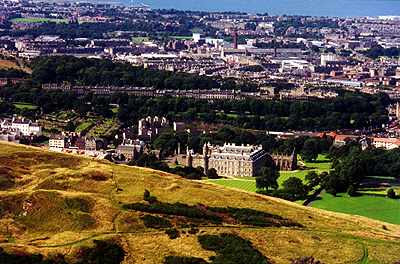
In the morning Pam and her mother went shopping. Some of the rest of the crew went to St Andrews for a game of golf. In the afternoon Ed insisted that we both climb Arthur's Seat. It was good training for walking St Cuthbert's Way. We made it and we got some good pictures considering that it was a cloudy day. The picture to the right shows the Holy Rood Palace in the foreground. The Royal Mile runs from the Holy Rood Palace, to the left, up to the Edinburgh Castle.
Monday evening the whole family had a gourmet meal at Martin's. Martin himself took care of us, but was disappointed when he learned that we were not wine drinkers and we were a little rushed in order to get to the Tattoo. The meal was outstanding. Then we followed the crowd up the hill (The Royal Mile) to the castle.
The Tattoo was wonderful although the bleacher seats were made for little people. Good thing--it was pretty chilly. We were too close together to get cold. Other than the Royal Bagpipers, the best was the Australian group with some aboriginies, cowgirls, and a huge digeradoo which was played throughout their presentation. There was also a great steel band from one of the islands.
August 22, Tuesday
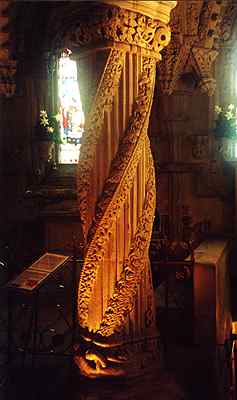
Ed and Pam took a taxi (£17.40 + tip) to Roslin to see the Rosslyn Chapel. We took a bus back for about £1.50 each. The Rosslyn Chapel, founded in 1446 by Sir William St Clair, is steeped in history and myth. We bought a couple of books that explain it all. The current chapel was built by the St. Clair family in collaboration with the Knights Templar. The chapel was built on a site that was believed to be the site of Celtic and Druid worship in earlier times. The spiritual history of the site is reflected in the many carvings symbolizing Christian, Judeaic, Egyptian, Celtic and Druid beliefs. Some carvings represent the traditions of the Templars, and their (alleged) Scottish heirs, the Masons. The chapel is only one wing of what was intended to be a huge cathedral, but the power and wealth of the Knights Templar was on the wane so the chapel was never finished. Rumors abound that the treasures of the Templars, who fled to Scotland after their banishment from France, are buried in the chapel.
There are two pillars associated with Solomonic mystical wisdom, possibly the secret traditions zealously guarded by the Cathar Parfaits and the Templar knights. The first of these pillars, the Apprentice Pillar (picture on the right), is in the chapel at Rosslyn, standing proud and alone and quite different from other pillars in the same location. The second of these pillars stands in solitary splendor in the market square of Cintra in Portugal. Between these two pillars is an ancient pilgrimage path, known as the Milky Way, which takes in sites of ancient spiritual significance in London, Amiens, Paris, Chartres, Orleans, Toulouse and the Church of Santiago (St James) de Compostela.
The chapel museum included a display of a picture of the last gypsie king and his house which was nearby. The St. Clairs were very tolerant of alternate cultures and religions, whereas other parts of the country were by then intolerant of the gypsies.
August 23-24-25, Wednesday, Thursday and Friday
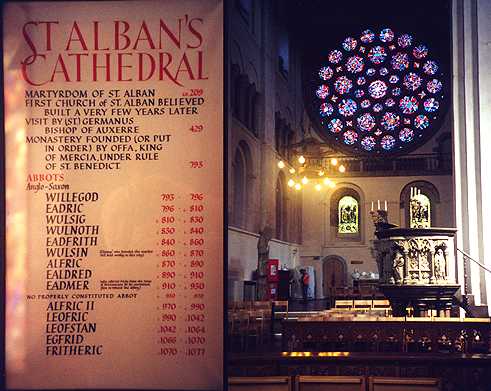
Train from Edinburgh to London. The Balmoral is right beside the train station so all twelve of us trecked out of the hotel, pulling our luggage, to the train station. We arrived at the London Kings Cross station and took taxis to the Mayflower Intercontinental Hotel.
Everyone did their own thing in London. Pam, Ed and Richard took the tour of Buckingham Palace. Then Pam and Ed went to tour Windsor Castle. Both, of course, are filled with magnificant splendor.
On Friday, following the advice of the taxi driver when we arrived in London, Ed and Pam went to St. Albans. This is another magnificent old cathedral and school. We ate in 'Ye Old Fighting Cocks' which is reputedly the oldest, continuosly licensed and operated pub in the country.
August 26 and 27, Saturday and Sunday
The rest of the family goes home while Ed and Pam travel from London back to Edinburgh to start the walk on St Cuthbert's Way. It was a bank holiday weekend (Monday off) and the train didn't get any sandwiches when it left London. They kept promising sandwiches at the next stop, but they never arrived. Near the train station we caught a bus to Innerleithen where we stayed one night before going on to Melrose to start our walk.
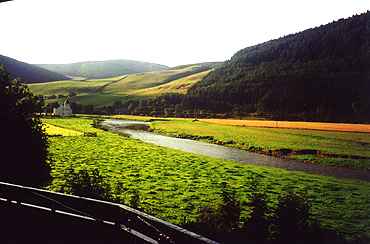 We were supposed to have reservations in Caddon View Guest House in Innerleithen. However, before leaving Edinburgh, the tour agency representative visited us to explain that the Caddon View had overbooked. They were to take us to another B&B, Eden View, a couple miles down the road. Since it was late and we were starved, we decided to pay for a meal at the Caddon View. It was an excellent dinner. Amar, our host, was originally from French North Africa and quite a prince of the bazaar. He was going to charge us non-resident rates for the meal, but when we argued that it was no fault of ours that we weren't staying there, he gave us the resident prices. The Eden View turned out to be a beautiful new house in one the most scenic sites imaginable. They build things there to last a couple of centuries. The view is of the River Tweed and the hills beyond it. The house has a second story balcony overlooking this scenic view. The owners have two extra rooms that they rent out during the tourist season. B&B's are a big thing in the small towns throughout The Scottish Borders region.
We were supposed to have reservations in Caddon View Guest House in Innerleithen. However, before leaving Edinburgh, the tour agency representative visited us to explain that the Caddon View had overbooked. They were to take us to another B&B, Eden View, a couple miles down the road. Since it was late and we were starved, we decided to pay for a meal at the Caddon View. It was an excellent dinner. Amar, our host, was originally from French North Africa and quite a prince of the bazaar. He was going to charge us non-resident rates for the meal, but when we argued that it was no fault of ours that we weren't staying there, he gave us the resident prices. The Eden View turned out to be a beautiful new house in one the most scenic sites imaginable. They build things there to last a couple of centuries. The view is of the River Tweed and the hills beyond it. The house has a second story balcony overlooking this scenic view. The owners have two extra rooms that they rent out during the tourist season. B&B's are a big thing in the small towns throughout The Scottish Borders region.
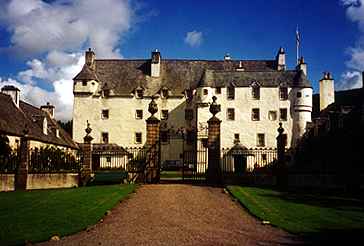 The next morning we walked up to Traquair House, Scotland's oldest, continuously inhabited house. It has deep roots in Scottish religious and political history stretching back over 900 years. To get there we walked about two miles along the Tweed, carefully circumventing the cows and their deposits, and half-a-mile up a country road. The house was a Catholic Stuart stronghold for about 500 years. The house has romantic associations with Mary, Queen of Scots, and Bonnie Prince Charlie. There is a picture of him in full kilt and another of him dressed as Flora MacDonald's maid--Betty Burke. Not a bad looking maid. They have a small brewery on the premises. Ed tried their Jacobite Ale which is 8.2% alcohol.
The next morning we walked up to Traquair House, Scotland's oldest, continuously inhabited house. It has deep roots in Scottish religious and political history stretching back over 900 years. To get there we walked about two miles along the Tweed, carefully circumventing the cows and their deposits, and half-a-mile up a country road. The house was a Catholic Stuart stronghold for about 500 years. The house has romantic associations with Mary, Queen of Scots, and Bonnie Prince Charlie. There is a picture of him in full kilt and another of him dressed as Flora MacDonald's maid--Betty Burke. Not a bad looking maid. They have a small brewery on the premises. Ed tried their Jacobite Ale which is 8.2% alcohol.
August 28, Monday
A taxi had been arranged to take us to our next stop--Melrose, where we spent two nights. We had delicious lamb cutlets in Burt's Hotel. The hostess at the B&B (Dunfermline House) did a load of laundry for us. While Ed took a walk around town, Pam was in the garden reading Watcher at Crystal Spring. This is a novel about England at the time of the Norman conquest. It is especially interesting after seeing Rosslyn chapel. It describes the role of Christianity as the formal, ritualistic, state religion, but with nature dieties still revered in secret by the people who knew the mysteries of those "religions." At Rosslyn it was the Templars and Masons. In the book, it was the village people. Even at Melrose Abby we read that early Christian missionaries did not destroy all the temples to the local dieties, but reconsecrated them as Christian shrines. Apparently, the cults of the saints was a way for the people to relate their Christian religion to their old ways. A lot was going on under the guise of the official Christianity.
After tromping around the Abby, we went for lunch at Burt's with Annie, back from New Zealand temporarily to settle her mother's affairs. Then we went looking for St Cuthbert's church--asking three people who didn't know before finding two elderly sisters out for a stroll along the Tweed. They directed us to a church we had just tried to get into, but with nothing to indicate its name. They explained that it had been named "St Cuthberts" some years ago.
August 29, Tuesday
See the documentary of Ed and Pam's walk on St Cuthbert's Way.
September 6, 2000 - Berwick Upon Tweed
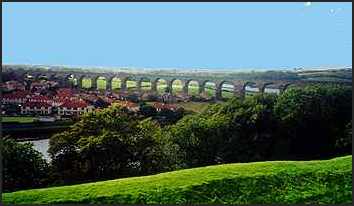 We arranged to go to Berwick-upon-Tweed early in the morning. It had to be early because of the tides, so we missed breakfast at our B&B. The shuttle bus dropped us at a B&B in Berwick and we were able to have breakfast there and read the paper in the lounge. At ten o'clock, we reported to the Tourist Information Center for the walking tour of the town. It is quite an interesting city, which passed back and forth between England and Scotland over a dozen times. The English claim it now, but there is still a Scots presence about the place, and the soccer team plays in the Scottish soccer league. The Royal Border Bridge, built 1847-1850, in the picture to the right is still the main rail line. The train station was at the right end of the bridge and right behind The Castle B&B where we stayed.
We arranged to go to Berwick-upon-Tweed early in the morning. It had to be early because of the tides, so we missed breakfast at our B&B. The shuttle bus dropped us at a B&B in Berwick and we were able to have breakfast there and read the paper in the lounge. At ten o'clock, we reported to the Tourist Information Center for the walking tour of the town. It is quite an interesting city, which passed back and forth between England and Scotland over a dozen times. The English claim it now, but there is still a Scots presence about the place, and the soccer team plays in the Scottish soccer league. The Royal Border Bridge, built 1847-1850, in the picture to the right is still the main rail line. The train station was at the right end of the bridge and right behind The Castle B&B where we stayed.
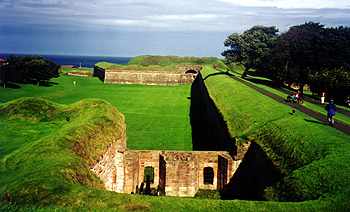 Elizabeth I built a state-of-the-art defense for the town. At the time it was built, Mary, Queen of Scots, was a competitor for the crown of England, and Mary had the support of the French. If the Scots and the French had elected to go to war, Berwick would have been a logical place to start. Even after the whole Scotland-England dispute became a moot point because the crowns were united, Berwick continued to have a strategic importance in the Jacobite revolutions, the Civil War, and the Napoleanic Wars. The garrison that started with Elizabeth I manned the walls, locked the gates and enforced a curfew on the town until 1815. One can walk the walls today and see how the defenses were constantly upgraded, from large early cannons, to cannons captured from Napoleon, to the mountings for World War II anti-aircraft guns. Oddly enough, the town is still at war. The Crimean war was declared on behalf of England, Scotland and Berwick-on-Tweed, which was an independent, royal borough at the time. It was settled in the name of England and Scotland, only. Technically, they are still at war with Russia. The history of the town is far more complex and interesting than I can summarize here. We bought a book to jog our memory years from now when we look back on this visit.
Elizabeth I built a state-of-the-art defense for the town. At the time it was built, Mary, Queen of Scots, was a competitor for the crown of England, and Mary had the support of the French. If the Scots and the French had elected to go to war, Berwick would have been a logical place to start. Even after the whole Scotland-England dispute became a moot point because the crowns were united, Berwick continued to have a strategic importance in the Jacobite revolutions, the Civil War, and the Napoleanic Wars. The garrison that started with Elizabeth I manned the walls, locked the gates and enforced a curfew on the town until 1815. One can walk the walls today and see how the defenses were constantly upgraded, from large early cannons, to cannons captured from Napoleon, to the mountings for World War II anti-aircraft guns. Oddly enough, the town is still at war. The Crimean war was declared on behalf of England, Scotland and Berwick-on-Tweed, which was an independent, royal borough at the time. It was settled in the name of England and Scotland, only. Technically, they are still at war with Russia. The history of the town is far more complex and interesting than I can summarize here. We bought a book to jog our memory years from now when we look back on this visit.
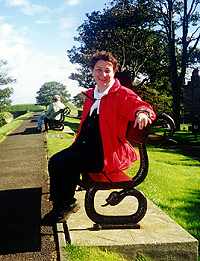 We did another lap around the walls, taking pictures that we had not taken during the walking tour (because it was raining). We captured a very nice shot of Lindisfarne, looking kind of milky in the afternoon mist, with Bamberg Castle across the way on the mainland. A wonderful little store in the High street sold muesli made at Heatherlaws Mill. This had been part of the breakfast at High Steads and we were happy to be able to take some home with us. Another stop was at a bookstore. We were looking at spending most of the next day on a train to London and the day after that on a plane to Washington, so we needed reading material to keep us occupied.
We did another lap around the walls, taking pictures that we had not taken during the walking tour (because it was raining). We captured a very nice shot of Lindisfarne, looking kind of milky in the afternoon mist, with Bamberg Castle across the way on the mainland. A wonderful little store in the High street sold muesli made at Heatherlaws Mill. This had been part of the breakfast at High Steads and we were happy to be able to take some home with us. Another stop was at a bookstore. We were looking at spending most of the next day on a train to London and the day after that on a plane to Washington, so we needed reading material to keep us occupied.
EPILOGUE: We want to do it again!. Next time we'll let Make Tracks arrange a walk on the West Highland Way.
Please send comments and questions to:

 After the service we went to the book fair in Charlotte Square. The children's tent was wonderful but we finally got to the adult tent. We bought two books: one on the Boothe's who founded the Salvation Army. Rev. Macmillan referred to it in his sermon. The other was a book on the Rosslyn Chapel which we planned to visit. We then walked down Rose street looking for a place to eat. Since this was about 3:00pm, most of the pubs had stopped serving food, or had run out. We ended up in the Kennilworth where we had some wonderful lamb and boiled potatoes--Ed with his two pints of ale and Pam with her lemonaid. Afterwards Ed climbed Arthur's Seat, the promontory and peak in the middle of Edinburgh. The picture to the right is taken from atop Arthur's Seat, showing Pam with Edinburgh in the background. If you look hard, you can see the Royal Yacht Britannia (decommissioned) at it's permanent docking place in the harbor.
After the service we went to the book fair in Charlotte Square. The children's tent was wonderful but we finally got to the adult tent. We bought two books: one on the Boothe's who founded the Salvation Army. Rev. Macmillan referred to it in his sermon. The other was a book on the Rosslyn Chapel which we planned to visit. We then walked down Rose street looking for a place to eat. Since this was about 3:00pm, most of the pubs had stopped serving food, or had run out. We ended up in the Kennilworth where we had some wonderful lamb and boiled potatoes--Ed with his two pints of ale and Pam with her lemonaid. Afterwards Ed climbed Arthur's Seat, the promontory and peak in the middle of Edinburgh. The picture to the right is taken from atop Arthur's Seat, showing Pam with Edinburgh in the background. If you look hard, you can see the Royal Yacht Britannia (decommissioned) at it's permanent docking place in the harbor.


 We were supposed to have reservations in Caddon View Guest House in Innerleithen. However, before leaving Edinburgh, the tour agency representative visited us to explain that the Caddon View had overbooked. They were to take us to another B&B, Eden View, a couple miles down the road. Since it was late and we were starved, we decided to pay for a meal at the Caddon View. It was an excellent dinner. Amar, our host, was originally from French North Africa and quite a prince of the bazaar. He was going to charge us non-resident rates for the meal, but when we argued that it was no fault of ours that we weren't staying there, he gave us the resident prices. The Eden View turned out to be a beautiful new house in one the most scenic sites imaginable. They build things there to last a couple of centuries. The view is of the River Tweed and the hills beyond it. The house has a second story balcony overlooking this scenic view. The owners have two extra rooms that they rent out during the tourist season. B&B's are a big thing in the small towns throughout The Scottish Borders region.
We were supposed to have reservations in Caddon View Guest House in Innerleithen. However, before leaving Edinburgh, the tour agency representative visited us to explain that the Caddon View had overbooked. They were to take us to another B&B, Eden View, a couple miles down the road. Since it was late and we were starved, we decided to pay for a meal at the Caddon View. It was an excellent dinner. Amar, our host, was originally from French North Africa and quite a prince of the bazaar. He was going to charge us non-resident rates for the meal, but when we argued that it was no fault of ours that we weren't staying there, he gave us the resident prices. The Eden View turned out to be a beautiful new house in one the most scenic sites imaginable. They build things there to last a couple of centuries. The view is of the River Tweed and the hills beyond it. The house has a second story balcony overlooking this scenic view. The owners have two extra rooms that they rent out during the tourist season. B&B's are a big thing in the small towns throughout The Scottish Borders region. The next morning we walked up to
The next morning we walked up to  We arranged to go to
We arranged to go to  Elizabeth I built a state-of-the-art defense for the town. At the time it was built, Mary, Queen of Scots, was a competitor for the crown of England, and Mary had the support of the French. If the Scots and the French had elected to go to war, Berwick would have been a logical place to start. Even after the whole Scotland-England dispute became a moot point because the crowns were united, Berwick continued to have a strategic importance in the Jacobite revolutions, the Civil War, and the Napoleanic Wars. The garrison that started with Elizabeth I manned the walls, locked the gates and enforced a curfew on the town until 1815. One can walk the walls today and see how the defenses were constantly upgraded, from large early cannons, to cannons captured from Napoleon, to the mountings for World War II anti-aircraft guns. Oddly enough, the town is still at war. The Crimean war was declared on behalf of England, Scotland and Berwick-on-Tweed, which was an independent, royal borough at the time. It was settled in the name of England and Scotland, only. Technically, they are still at war with Russia. The history of the town is far more complex and interesting than I can summarize here. We bought a book to jog our memory years from now when we look back on this visit.
Elizabeth I built a state-of-the-art defense for the town. At the time it was built, Mary, Queen of Scots, was a competitor for the crown of England, and Mary had the support of the French. If the Scots and the French had elected to go to war, Berwick would have been a logical place to start. Even after the whole Scotland-England dispute became a moot point because the crowns were united, Berwick continued to have a strategic importance in the Jacobite revolutions, the Civil War, and the Napoleanic Wars. The garrison that started with Elizabeth I manned the walls, locked the gates and enforced a curfew on the town until 1815. One can walk the walls today and see how the defenses were constantly upgraded, from large early cannons, to cannons captured from Napoleon, to the mountings for World War II anti-aircraft guns. Oddly enough, the town is still at war. The Crimean war was declared on behalf of England, Scotland and Berwick-on-Tweed, which was an independent, royal borough at the time. It was settled in the name of England and Scotland, only. Technically, they are still at war with Russia. The history of the town is far more complex and interesting than I can summarize here. We bought a book to jog our memory years from now when we look back on this visit. We did another lap around the walls, taking pictures that we had not taken during the walking tour (because it was raining). We captured a very nice shot of Lindisfarne, looking kind of milky in the afternoon mist, with Bamberg Castle across the way on the mainland. A wonderful little store in the High street sold muesli made at Heatherlaws Mill. This had been part of the breakfast at High Steads and we were happy to be able to take some home with us. Another stop was at a bookstore. We were looking at spending most of the next day on a train to London and the day after that on a plane to Washington, so we needed reading material to keep us occupied.
We did another lap around the walls, taking pictures that we had not taken during the walking tour (because it was raining). We captured a very nice shot of Lindisfarne, looking kind of milky in the afternoon mist, with Bamberg Castle across the way on the mainland. A wonderful little store in the High street sold muesli made at Heatherlaws Mill. This had been part of the breakfast at High Steads and we were happy to be able to take some home with us. Another stop was at a bookstore. We were looking at spending most of the next day on a train to London and the day after that on a plane to Washington, so we needed reading material to keep us occupied.